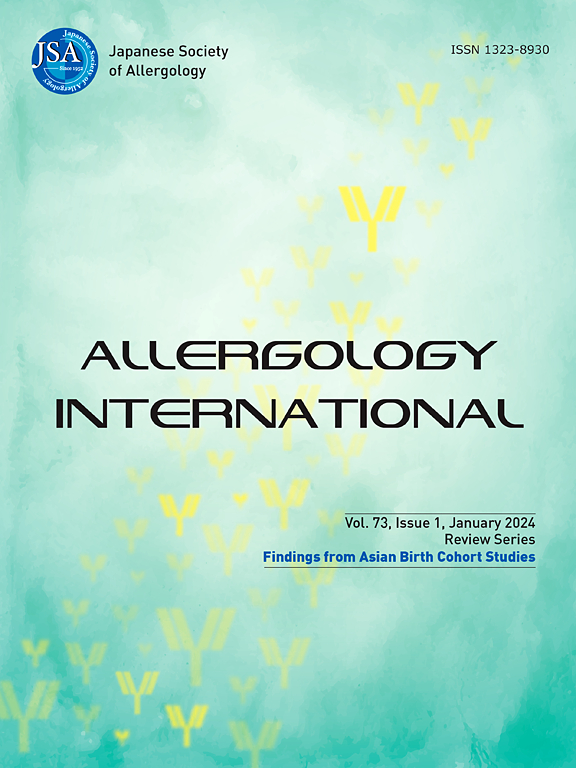Peach component-specific IgE measurement helps to differentiate between local and systemic reactions in peach-allergic Japanese patients
IF 6.7
2区 医学
Q1 ALLERGY
引用次数: 0
Abstract
Background
Component-resolved diagnostics are used to diagnose food allergies. Currently, reports on sensitization profiles using peach-allergen components in a multicenter setting are lacking. In this study, sensitization profiling of peach allergy was performed to evaluate the clinical utility of each component specific-immunoglobulin E antibody (sIgE ab) test.
Methods
Sixty-seven patients with peach allergy were enrolled at four Japanese centers and classified into a local reaction group (LR) with only oral or pharyngeal mucosal symptoms in 36 patients and a systemic reaction group (SR) without LR in 31 patients. Serum sIgE ab tests to peach crude, Pru p 1, Pru p 3, Pru p 4, Pru p 7, and tree pollen were conducted.
Results
In the receiver operating characteristic curve analysis, Pru p 1 had the highest area under the curve (AUC) for diagnosing LR, followed by Pru p 4, which outperformed peach crude allergen. Pru p 7 had the highest AUC for diagnosing SR, with the other peach allergen components and peach crude allergen showing lower values.
Conclusions
Sensitization to Pru p 1 was associated with LRs, while sensitization to Pru p 7 was associated with SRs; approximately one-third of patients in the SR group tested negative for the titer of peach crude sIgE ab, many of whom tested positive for the titer of Pru p 7 sIgE ab. We conclude that measuring Pru p 1, Pru p 4, and Pru p 7 sIgE ab titers is useful to differentiate LRs and SRs in peach-allergic Japanese patients.
桃子成分特异性IgE测量有助于区分桃子过敏日本患者的局部和全身反应。
背景:组件解析诊断用于诊断食物过敏。目前,关于在多中心环境下使用桃子过敏原成分致敏概况的报告缺乏。本研究对桃过敏进行致敏分析,以评价各成分特异性免疫球蛋白E抗体(sIgE ab)检测的临床应用价值。方法:选取日本4个中心的67例桃子过敏患者,将36例患者分为仅出现口腔或咽粘膜症状的局部反应组(LR)和31例无LR的全身反应组(SR)。采用血清sIgE抗体检测桃树粗、prup1、prup3、prup1、prup1、prup1、prup1、prup1、prup3、prup1、prup1和树花粉。结果:在受试者工作特征曲线分析中,Pru p1诊断LR的曲线下面积(AUC)最高,Pru p1次之,其诊断效果优于桃粗过敏原。prpr7诊断SR的AUC最高,其他桃子过敏原成分和桃子粗过敏原的AUC较低。结论:prup1致敏与LRs相关,prup7致敏与SRs相关;SR组中约有三分之一的患者检测桃源sIgE抗体滴度为阴性,其中许多人检测Pru p7 sIgE抗体滴度为阳性。我们得出结论,检测Pru p1、Pru p4和Pru p7 sIgE抗体滴度有助于区分桃子过敏的日本患者的LRs和SR。
本文章由计算机程序翻译,如有差异,请以英文原文为准。
求助全文
约1分钟内获得全文
求助全文
来源期刊

Allergology International
ALLERGY-IMMUNOLOGY
CiteScore
12.60
自引率
5.90%
发文量
96
审稿时长
29 weeks
期刊介绍:
Allergology International is the official journal of the Japanese Society of Allergology and publishes original papers dealing with the etiology, diagnosis and treatment of allergic and related diseases. Papers may include the study of methods of controlling allergic reactions, human and animal models of hypersensitivity and other aspects of basic and applied clinical allergy in its broadest sense.
The Journal aims to encourage the international exchange of results and encourages authors from all countries to submit papers in the following three categories: Original Articles, Review Articles, and Letters to the Editor.
 求助内容:
求助内容: 应助结果提醒方式:
应助结果提醒方式:


